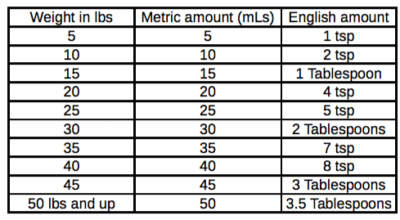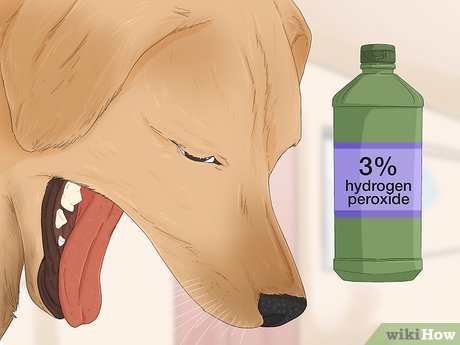To make a dog throw up, the recommended dosage of hydrogen peroxide is 1 teaspoon per 5 pounds of the dog’s body weight. It’s essential to consult a veterinarian before inducing vomiting in a dog with hydrogen peroxide.
When a dog ingests something toxic, it can be a stressful situation for pet owners. Knowing how to safely induce vomiting in dogs can be crucial in these situations. By following the appropriate steps and consulting a veterinarian, you can effectively use hydrogen peroxide to make your dog vomit and potentially prevent the absorption of a harmful substance.
However, it’s important to administer the correct dosage based on your dog’s weight and to seek professional advice to ensure the safety and well-being of your pet.
The Dangers Of Ingesting Hydrogen Peroxide
When it comes to our furry friends, their safety and well-being are always our top priority. However, accidents can happen, and sometimes our dogs may ingest substances that are harmful to them. One such substance is hydrogen peroxide. While hydrogen peroxide can be used to induce vomiting in dogs under certain circumstances, it is vital to understand the potential dangers of ingesting this solution. In this section, we will explore how hydrogen peroxide affects dogs, the potential risks of inducing vomiting using hydrogen peroxide, and the importance of consulting a veterinarian.
How Hydrogen Peroxide Affects Dogs
Hydrogen peroxide is a commonly found household item that is used for various purposes. However, when it comes to dogs, ingesting this solution can have detrimental effects on their health. When a dog ingests hydrogen peroxide, it reacts with an enzyme called catalase present in their blood, releasing oxygen gas.
This release of oxygen gas can lead to various side effects in dogs, including stomach upset, irritation of the gastrointestinal tract, and the potential for damage to the delicate lining of the stomach and intestines. Additionally, the oxygen released can cause foaming and bubbling, which may further agitate the dog’s stomach and throat.
The severity of these effects can vary depending on the quantity of hydrogen peroxide ingested and the size and health of the dog. It is crucial to remember that each dog is different, and what might be safe for one dog could be harmful to another.
Potential Risks Of Inducing Vomiting
Inducing vomiting in dogs using hydrogen peroxide can be a risky endeavor. While it may be necessary in some cases, such as when a dog ingests something toxic like chocolate or a harmful substance, it is important to consider the potential risks involved.
One significant risk is the aspiration of vomit into the dog’s lungs. When a dog vomits, there is a chance that the vomit can enter their airway instead of being expelled fully. This aspiration can lead to pneumonia or other respiratory issues, which can be life-threatening.
Moreover, inducing vomiting using hydrogen peroxide can also be an uncomfortable and distressing experience for dogs. The foaming and bubbling caused by hydrogen peroxide can trigger panic and stress in dogs, exacerbating their physical discomfort.
Consulting A Veterinarian
Given the potential dangers and risks associated with inducing vomiting using hydrogen peroxide, it is crucial to consult a veterinarian before taking any actions. Veterinarians are highly trained professionals who can assess the situation and provide appropriate advice.
They can determine whether inducing vomiting is necessary based on the substance ingested and the dog’s overall health. They may also guide you on the safest and most effective methods to facilitate vomiting if required. Consulting a veterinarian ensures that your dog receives the best possible care and minimizes the risks associated with using hydrogen peroxide on your own.

Credit: vetchick.com
Determining The Amount Of Hydrogen Peroxide
Determining the right amount of hydrogen peroxide for inducing vomiting in your dog is crucial for ensuring their safety and well-being. It’s important to follow weight-based dosage guidelines and calculate the correct dosage with precision. Using a syringe can ensure accuracy, making the process more effective.
Weight-based Dosage Guidelines
When it comes to determining the amount of hydrogen peroxide to make a dog throw up, it’s essential to consider their weight. The generally recommended dosage is 1 teaspoon (5 ml) of 3% hydrogen peroxide per 10 pounds (4.5 kg) of body weight. It’s advisable to consult a veterinarian before administering hydrogen peroxide to your dog to ensure you are using the correct dosage for their specific weight.
Calculating The Correct Dosage
Before administering hydrogen peroxide to your dog, calculating the correct dosage is crucial. If you know your dog’s weight, you can easily calculate the amount of hydrogen peroxide needed by using the weight-based guidelines mentioned earlier. However, if you are unsure about the dosage, it’s best to seek advice from a professional veterinarian.
Using A Syringe For Accuracy
Using a syringe is highly recommended for measuring the hydrogen peroxide accurately. This ensures that you are administering the precise dosage as advised by the weight-based guidelines. The use of a syringe can help avoid any errors in measurement, offering peace of mind that you are inducing vomiting in a safe and controlled manner.
Step-by-step Guide To Inducing Vomiting
If your dog has ingested a potentially harmful substance, inducing vomiting can help remove it from their system before it causes serious harm. This step-by-step guide will walk you through the process of using hydrogen peroxide to make your dog throw up, but remember, always consult a veterinarian before attempting this on your own.
Gathering The Necessary Supplies
Before you begin, gather the following supplies:
- A fresh bottle of 3% hydrogen peroxide
- A large syringe or turkey baster
- Gloves
- A towel or newspaper to clean up any mess
- A smartphone or watch to time the process
Preparing The Solution
Now, follow these simple steps to prepare the hydrogen peroxide solution:
- Use the recommended dosage: 1 teaspoon of 3% hydrogen peroxide per 5 pounds of your dog’s body weight, up to a maximum of 45 ml (3 tablespoons).
- Draw the correct amount of hydrogen peroxide into the syringe or turkey baster.
- Double-check the dose based on your dog’s weight before proceeding.
Administering Hydrogen Peroxide
Now it’s time to administer the solution to your dog:
- Calmly and gently restrain your dog, if necessary, to prevent them from running away during the process.
- Place the syringe or turkey baster into the back of your dog’s mouth, near the molars, and slowly squirt the hydrogen peroxide into their mouth.
- Do not force your dog to swallow, but do not allow them to spit out the solution.
Monitoring The Dog’s Response
After administering the hydrogen peroxide, observe your dog’s response:
- Take your dog for a walk to encourage them to move around and mix the solution in their stomach.
- Expect your dog to vomit within 10-15 minutes. If they don’t, consult a veterinarian immediately.
- Continue to keep a close eye on your dog for any signs of distress or adverse effects.

Credit: www.youtube.com
What To Do After Inducing Vomiting
After successfully inducing vomiting in your dog using hydrogen peroxide, it’s crucial to take the necessary steps to ensure your pet’s safety and well-being. There are a few key aspects to consider, including observing the dog’s condition, seeking further veterinary care, and preventing future accidents. Let’s dive into each of these aspects:
Observing The Dog’s Condition
After your dog has vomited, it’s essential to keep a close eye on their condition. Observe their behavior and look out for any signs of distress or unusual symptoms. Pay attention to their breathing, body temperature, and overall demeanor. If you notice anything concerning or if your dog’s condition worsens, it’s important to seek immediate veterinary assistance.
Seeking Further Veterinary Care
In some cases, induced vomiting may not be entirely effective or may lead to other complications. If you have any doubts or if your dog ingested a toxic substance or a large amount of a harmful material, it’s advisable to consult with a veterinarian. They have the expertise and knowledge to assess the situation and provide further treatment if necessary. Remember, a veterinarian is your best resource when it comes to the health and well-being of your furry friend.
Preventing Future Accidents
Now that you’ve dealt with the immediate situation and ensured your dog’s safety, it’s crucial to take steps to prevent future accidents. Dogs are naturally curious creatures and can get themselves into trouble if they encounter harmful substances or objects. Here are a few measures you can take to minimize the risk:
- Store household chemicals, medications, and toxic plants high up and out of reach.
- Secure garbage bins to prevent your dog from accessing harmful substances.
- Keep an eye on your dog when outdoors to prevent them from ingesting potentially harmful substances in the environment.
- Consider using childproof locks on cabinets and drawers where dangerous items are stored.
- Train your dog to “leave it” or “drop it” commands, which can be useful in preventing them from picking up hazardous items.
By implementing these preventative measures, you can create a safer environment for your dog and reduce the risk of future accidents.
In conclusion, after inducing vomiting in your dog, it’s crucial to observe their condition, seek further veterinary care if needed, and take steps to prevent future accidents. Your furry friend’s well-being is of utmost importance, and by following these guidelines, you can ensure their safety and happiness.

Credit: www.wikihow.com
Frequently Asked Questions On How Much Hydrogen Peroxide To Make A Dog Throw Up
How Much Hydrogen Peroxide Is Safe For A Dog To Ingest?
The safe amount of hydrogen peroxide to make a dog throw up is 1 teaspoon per 10 pounds of body weight. However, it’s always best to consult with a veterinarian before inducing vomiting in your dog, as they can provide specific guidance based on your dog’s unique situation.
What Are The Risks Of Using Hydrogen Peroxide To Make A Dog Throw Up?
While hydrogen peroxide can be effective in making a dog throw up, it should be used with caution. Ingesting large amounts of hydrogen peroxide can lead to stomach irritation, ulcers, and even chemical burns. It’s important to follow the proper dosage and seek veterinary advice before administering hydrogen peroxide to your dog.
How Should I Administer Hydrogen Peroxide To Make My Dog Throw Up?
To administer hydrogen peroxide to your dog, use a syringe or turkey baster to squirt the appropriate amount into the back of their throat. It’s crucial to be gentle and careful during this process to avoid choking or aspiration. Once administered, take your dog for a short walk to encourage vomiting within a few minutes.
Can I Use Any Strength Of Hydrogen Peroxide To Make My Dog Throw Up?
It is recommended to use a 3% hydrogen peroxide solution to induce vomiting in dogs. Higher concentrations can be harsh on the stomach lining and may cause harm. Stick to the recommended strength and always consult with a veterinarian before using hydrogen peroxide or any other treatment on your dog.
Conclusion
It is crucial to approach the issue of hydrogen peroxide and inducing vomiting in dogs with caution and under the guidance of a veterinarian. Administering the correct dosage is crucial to ensure your pet’s safety. Remember, your dog’s well-being is of utmost importance.
Always consult a professional for guidance and advice tailored to your pet’s specific needs.



